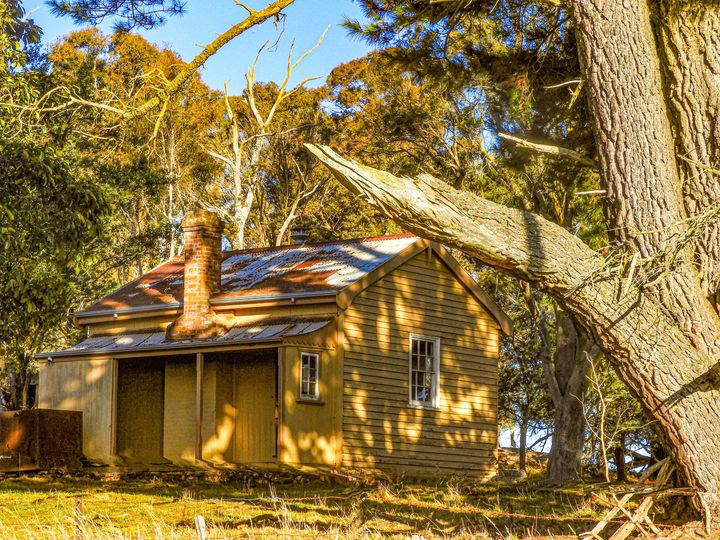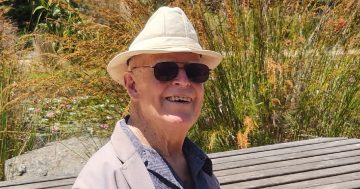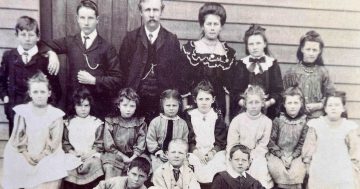
Burra Lake School north of Taralga may be falling into decline but still attracts attention and sparks memories of lone teachers who supervised a classroom of children from five to 15. Photo: Neville Friend.
Some years ago while repairing a little weatherboard school near Burra Lake north of Taralga, Crookwell builder Sean Proudman came across a concrete map of the world that left him intrigued.
About the width of a footpath, the map was installed in the playground.
“I’ve been in the trade over 40 years, and I knew the skill level required for that map of the world would not have been small,” the retired builder who has done much heritage restoration said. “You would have had to be very handy, and precise to get the levels right,” he said.
Recently, when Goulburn farmer and sharp-eyed photographer Neville Friend posted a photo of the bush school on Facebook a flood of comments followed, including from Rod McInnes who uncovered more about the mysterious map of the world from a 1937 Goulburn Evening Penny Post story.
It reported teacher Neil Halloran, pupils and members of the parents and citizens association working on the map for several months, outlining continents, oceans, principal islands and chief trade routes of the (British) empire.
Everyone who attended the Burra Lake school remembers the map, including Brian Moloney, who lived about 400 yards away opposite the school. Aged only four, he was sent to school to help keep it viable in 1954. From a dairy farming family, Brian’s brother Ian and sister Margaret were already attending the school which stood on the property of Leo and Kath Croke, whose children had also been pupils there.
On his first ever posting, the teacher Tony Sherlock thought Burra Lake would be on the coast somewhere. “So he was fairly surprised to find where it was,” Brian said. Having no teacher’s residence, he boarded with the families of his pupils, alternating with different ones over the succeeding months. “I got to have a few rides behind him on his motorbike which I thought was great back then,” Brian said.
“The chap who drove the milk truck and picked up the milk every morning in cans told me there were 48 dairies just after the war, around that Taralga area,” Brian said.
Rose Divall (nee Wright) remembers the milk truck when she went to the school. “If the weather was bad I would get a lift on the milk truck,” she said. Children who rode their ponies to school left them in a nearby pony paddock.
Children hung their coats up on the verandah. An open fire in the classroom provided winter heating and children ate their lunch in a weather shed. A toilet was about 50 yards away.
Rose’s sister Joy Goodwin wrote a short story about her acute shyness at the school. “My first day I was very nervous and became frozen to my seat in class, so shy I was afraid to ask to go to the toilet; subsequently there was a puddle under me. Grace McKenzie took me in hand for the rest of the day,” she said.
“That shy little girl still remains in me today. What I remember mostly was the beautiful map of the world, set in cement in the front of the school within the garden. This is where we sometimes had lessons.
“Another incident was the day a plane crashed into the lake, fortunately it was mostly dry. Everyone rushed outside hoping to get a glimpse of it,” Joy said. Brian remembers Joy’s brother Max saying the plane crash happened in the early 1940s.
Joy remembers when World War II ended. “… we went off to school to tell the teacher, but he wouldn’t believe us until Leo Croke came to the school to confirm it, and we were all let go home for the day,” she said.
“Our teacher of the time was not a very patient person, a couple of the older boys were very disruptive, I won’t name anybody but the cane somehow disappeared,” Joy wrote. “In despair the teacher got a branch off a tree to replace it. He went to use it on one of the boys and on impact it broke up. The whole classroom burst into laughter. The only other ammunition was to throw the blackboard duster.”
The weatherboard school standing today opened in 1912 and closed in 1955.
Brian said many of the dairies closed in the 1950s when wool became a more valued commodity, leaving fewer families to support the school. As well, a bus service began collecting children from Wombeyan Caves and from around Burra Lake, to deliver children to either the convent or public schools at Taralga, leaving behind generations of childhood memories.
Original Article published by John Thistleton on About Regional.














